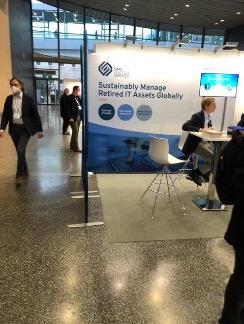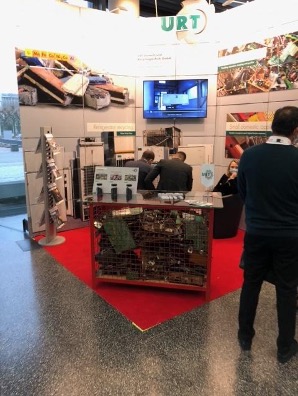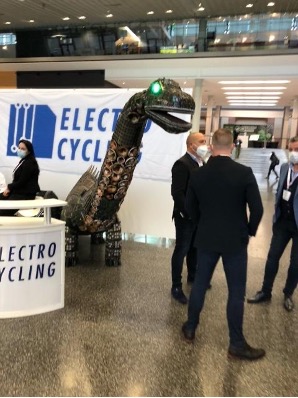Reflections on the International eWaste Forum and the opportunity for sustainable IT in 2022
Taking the train from London to Frankfurt to visit the eWaste World Conference & Expo, Cistor CEO, Anthony Levy, had plenty of time to reflect on how carbon-producing behaviour needs to change in order to meet the climate challenge facing all of us.* It makes him more determined than ever to support businesses to take a more sustainable approach to ICT in 2022.
Summary
- Our use of IT needs to be more sustainable. It’s still fragmented but, from mainstream advertising to companies using it as their core strategy, momentum is building
- There’s still only a small number of recyclers taking a fully circular approach to sustainable IT, and building software tools around it. Many recyclers at this event were focusing on just that; shredding the products into materials that can be processed and sold.
- Governments across Europe are beginning to mandate non-new for their own use; more signals that change is coming. New legislation and regulations will add an extra burden on manufacturers, resellers, and recyclers in order to facilitate the end-to-end process.
- Circular Economics adoption is vital, but understanding the psychology of what prevents organisations from using more sustainable IT will be key to make non-new technology mainstream.
The importance of sustainable IT
In the underground on my way out of London to Frankfurt I saw many adverts for Backmarket, a business-to-consumer platform for refurbished tech, and in the Frankfurt main station there was a sign for ‘Digital for Germany’, highlighting how digital has a key role to make Germany greener. The association of using technology to make us greener has been around a long time, but that technology itself can be greener is now coming slowly into the minds of society.
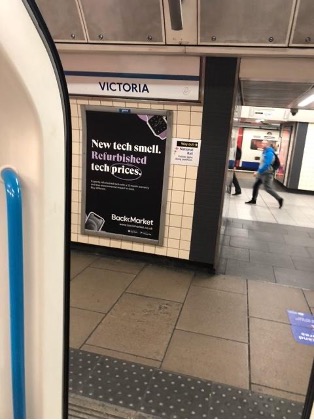
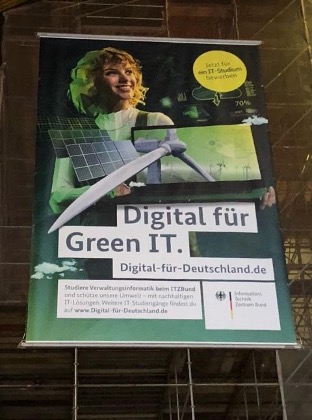
The conference was a relatively humble affair, a far cry from the tens of thousands of visitors I’ve seen at Cisco or other tech conferences which promote shiny new tech, and not helped by the latest COVID rules. The Global eWaste conference and expo is a more targeted event, historically focussing on recovering materials from eWaste and the challenges faced in this industry. But now, with eWaste dumps making the news, campaigns to extend the life of electricals and the right to repair movement growing in magnitude, eWaste has become more of a mainstream issue and more relevant than ever as people become familiar with the problem.
The audience comprised some academics and government policy makers, but mostly recyclers themselves and those who support that industry with machinery and capability.
This industry is mature at some levels, with several big players talking about 100-year histories, but the industry faces many challenges particularly in terms of proving its credentials in actually making a greener planet.
The role of government and entrepreneurs
There was lots of discussion about government intervention, and concerns about how developed countries are actually exporting harm and on the flip side many that say this intervention is preventing more recycling from happening by infringing on innovation and entrepreneurial drive. At other levels it’s an industry trying to keep up with the incredible speed of change. I spoke to one academic who is struggling to find even one company in Europe that recycles solar panels, one of the technologies we hope will help us combat global warming, and no one appears to be closing the loop. Again, technology develops so fast, but the technology hasn’t always been developed with ‘sustainable by design’ principles.
The most common approach is to shred all the eWaste material that comes in and sort it, be it plastics, metals, and other materials extracted out of white goods, batteries, solar panels, and of course mobiles, laptops and other IT. As I type on my laptop this feels a somehow brutal and barbaric approach to the expensive, delicate and incredibly complex piece of technology we invest so much in to make. In fact, this process is not even that effective at getting the materials back out of eWaste, as it’s extremely difficult with at best ~45% of materials being recovered in Europe and only ~17% worldwide, and only a few of those recovered are the rarest, most needed materials.
So, more must be done to stop these high planetary cost products being ground down whilst there is still life in them. We must take a more circular approach to IT and get maximum utility from what we have.
At governmental level, new legislation is slowly moving through Europe with France looking to lead the way with a durability index for products and targeting a high proportion of product reuse, but this is not a centralised solution across the whole EU, although policy makers are trying to encourage a 20% adoption of refurbished equipment. The United Kingdom has already passed this legislation.
A couple of big changes to watch out for:
Digital Product Passports – expected to come into play towards the end of next year will require products to travel with a digital description of what they are and where they come from.
Extended Producer Responsibility (EPR) – where countries will begin to put the responsibility for waste and packaging, including waste from electrical and electronic equipment (WEEE) responsibilities. This may well be passed down to resellers like us if products are sold on marketplaces like Amazon. Expectation is that this may come into life as soon as January 2023 for France and July 2023 for Germany.
There was also plenty of discussion around demand for raw materials for technology going up rapidly, such as a 16x demand increase for Lithium in the next 10 years, and traditional supply going down. Our planet’s resources will run out based on current consumption rates, which is why a more sustainable approach to IT is needed.
The Circular Economy offers a solution
Quite a lot was mentioned on the Circular Economy but few discussed more than one part of it, giving the feeling that the industry is very fragmented with lots of parts but little in the way of end-to-end solutions. KPMG ran a session highlighting a statistic I had heard elsewhere which is, as a planet we are only 8.6% circular today, that means only 8.6% of all the materials produced are kept within the economy. They also covered a case study with KPN, a Dutch telecommunications company, who have succeeded in using the Circular Transition Indicators (CTI) framework [https://ctitool.com/cti-framework-2/] to measure and improve their circularity.
A lot of investment is going into the Circular Economy, and the European Innovation Council will finance grants for research and tools.
The Global Electronics Council (GEC) is a not-for-profit that is trying to create greater buying power to change OEM behaviour, creating ecolabels like EPEAT, and working closely with certification bodies to do this.
Sims Lifecycle Services [https://www.simslifecycle.com/] presented their business approach and their progress. They have a purpose to “create a world without waste to preserve our planet”, and went some way to empathise collaboration; wanting to work with others with a similar purpose. They have been part of some large groups trying to address the Circular Economy in electronics. The Circular Electronics Partnership (CEP) [www.cep2030.org] is a significant example, and aims to bring organisations together to tackle some of the fragmentation in tech, consumer goods, and waste management. The CEP positions itself as a circular IT Asset Disposition (ITAD) organisation, dealing in data centres, infrastructure (telco), and devices. They have helped 2.1 million assets be repurposed in 2020.
